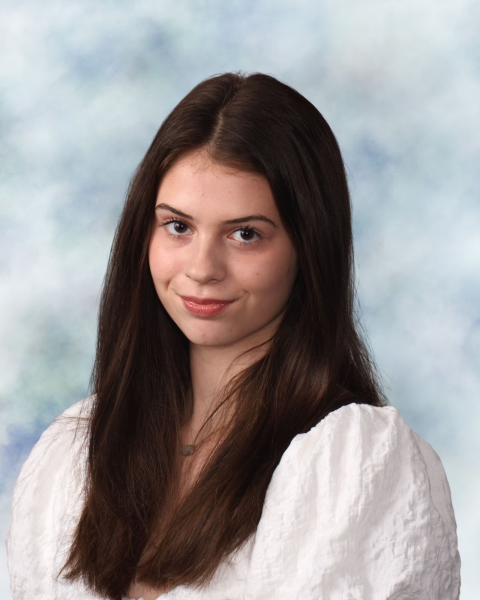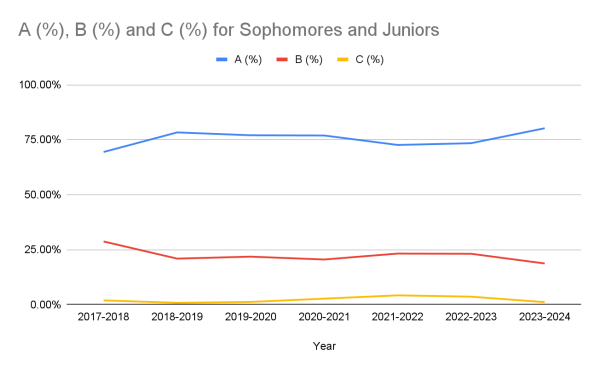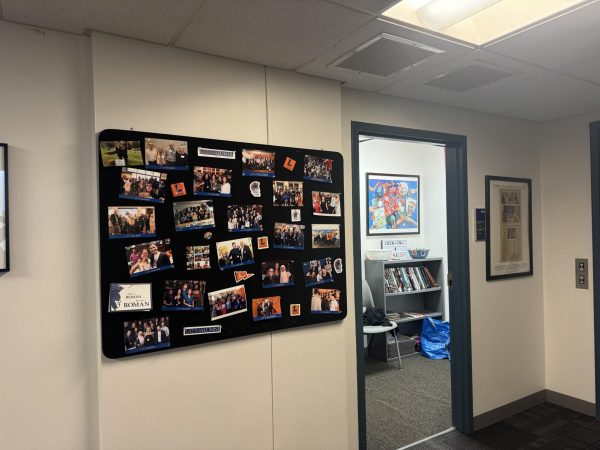Latin Lifers Put Their Feet on the Gas for Accelerated Math Courses
Juniors Aislinn Curry, Lia Ruiz, and Scarlett Lipe doing math homework.
Eleven students sit at triangular desks ready to learn in this year’s Honors Accelerated Precalculus class. Seven of these students are juniors and four are sophomores. And all four of those sophomores are “Latin lifers,” students who attended Latin long before entering the Upper School.
In Middle School, Latin splits students into math class levels distinguished as accelerated and regular. After advancing to the Upper School, those on the accelerated math track take Honors Geometry their freshman year and Honors Precalculus their sophomore year. The majority of Latin newcomers, and those on the regular track, reach Precalculus as juniors.
Sophomore Ralu Nzelibe was on the accelerated math track in Middle School and is currently taking Honors Accelerated Precalculus. While Ralu enjoys his math class, he sees some flaws in the current placement system.
“I would say that sometimes people get placed in lower classes than they’re actually supposed to be in just because they weren’t in [accelerated] math in eighth grade,” Ralu said.
For those in accelerated math, pre-Algebra, Algebra 1, and Algebra 2 are all completed in Middle School. Meanwhile, those not placed in the accelerated math class learn less advanced material. “It would be better if there was a more extensive test when you get into [Upper School],” Ralu said.
Unlike Ralu, junior Kira Mahoney was not on the accelerated math track in Middle School. However, she is currently a junior in Honors Accelerated Precalculus. “I upped my math game in high school,” Kira said. “I wish I started working towards more advanced math in Middle School, then I probably would have been in Calculus now, but I’m glad there’s a class that kind of lets me make up for what I was not doing in Middle School.”
Upper School math teacher Chris van Benthysen, Ralu and Kira’s current teacher, believes exposure is key to understanding more advanced math. “[Some students] probably were capable of working through that material successfully at that age but didn’t have the opportunity,” he said. “In the Upper School, we have a lot more opportunities for readjustment.”
Every year, the Math Department meets to discuss the placement of students. “Just because you were in regular Algebra 2 one year doesn’t mean you’re automatically going to regular Geometry the following year, and vice versa,” Mr. van Benthuysen said.
Latin is unique in its offering of Honors Accelerated Precalculus and Differential Calculus. It allows students in Honors Accelerated Precalculus to take AP Calculus BC without taking a full year of AP Calculus AB, and not all schools function this way.
Mr. van Benthuysen said, “What [Latin’s] doing makes sense for us as a school because of the structure of our schedule and school year.” Latin’s start date is later than most other schools, and Latin also has fewer classes in March due to Project Week and spring break. Latin’s AP Calculus BC curriculum is split into three semesters, and a third of it is taught during the Honors Accelerated Precalculus class a year before. The reason for this timing is to ensure students are prepared for the AP test in May.
Students who took regular Honors Precalculus could take AP Calculus BC after AB or get special permission to take both BC and AB Calc simultaneously. The Math Department can also grant permission for non-honors Precalculus graduates to take AP Calculus AB.
Senior Carmen Quiñones, who joined Latin as a freshman, took Honors Accelerated Precalculus last year. “[Taking] an advanced math class made sense because it opened up more platforms for me to take advanced physics,” she said.
Carmen added, “For someone who joins Latin from another school, you need to be really committed to have your credit taken for your class. The pathways that exist are very limiting to non-Latin middle schoolers.”

Caroline McHugh (‘25) is excited to serve as an Editor-in-Chief this year! She loves writing on issues important to the Latin community—whether that...
























































